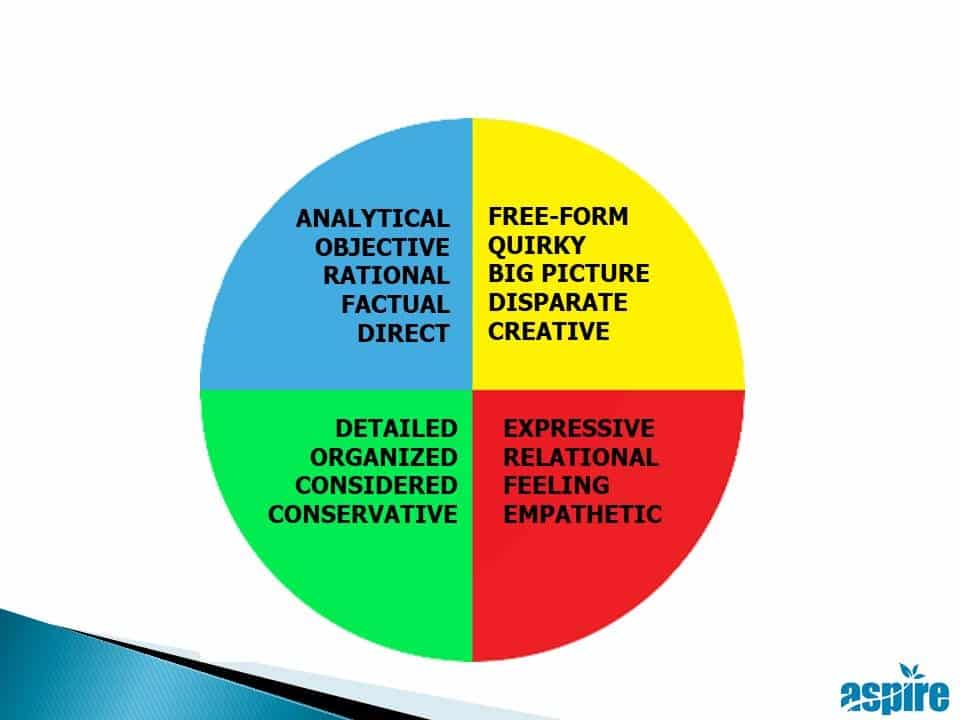“There’s this person I work with who drives me absolutely nuts – she needs to know every damn thing I do down to the finest detail.”
“She’s been an absolute godsend compared to our previous boss – her instructions are so clear and I know exactly what she expects from me.”
They were both talking about the same person. The person who is driven nuts said he’s reached a stage where when his manager starts speaking, he listens for a while, catches the gist of what she’s on about and then switches off. His colleague who sees her new boss as a ‘godsend’ can’t seem to get enough and loves keeping her informed of everything she’s working on. Favouritism? Maybe there’s a rational explanation for why we listen selectively.
“There are people we connect with instantly – who are on the same high-speed 5G connection as us…. and there are people who are still on a dial-up connection when we talk to them.”
Seen through the lens of The Herrmann Brain Dominance Instrument (HBDI) there is an explanation. If you have a preference for Blue thinking, you are likely to prefer communicating in very precise, rational and objective terms – if there is no supporting data to back an argument, it’s a non-starter. You are likely as well to prefer direct, non-evasive communication. So, naturally, people who speak to you in these terms are likely to be ‘memorable’ as far as you are concerned. If someone tries to sway you on the basis of an emotive ‘please lah’ argument, they are likely to be memorable as well but for all the wrong reasons.

Red thinking, on the other hand, is communication that must have a relational, interpersonal basis. If you have a preference for Red-dominant thinking, you would need to sense authenticity from the person you are speaking with and probably prefer to communicate on the basis of establishing an interpersonal connection first. Anyone who talks to you in language that you regard as ‘cold’ and impersonal will not make a good impression.
The manager referred to at the start of this article is Green through and through. She has a clear preference for detail and her communication centers around it. Not being one who is given to spontaneity, she thinks carefully and plans what needs to be communicated so that no mistakes are made and meaning is not misconstrued. Anyone who spoke to her in a broad or loosely structured manner was seen as disorganised and not quite trustworthy. Her direct report who saw her as a ‘godsend’ shared the same Green dominance – they ‘got’ each other because they shared the same style of communication.
Her direct report who was ‘driven nuts’ had a Yellow-dominant communication style. With him, the vaguest of instructions with some idea of what needed to be delivered was all he needed. He would be able to fill in the blanks using his imagination. Anyone who got into minute detail with him (like his new manager) would find his eyes glazing over. He was creative, quirky and thought at speed – one train of thought often colliding into another – but he was perfectly comfortable communicating in this way. Feeling most at home with other creatively inclined colleagues, he saw people who needed structure and detail as beings of lesser intelligence who needed to be spoon-fed.
We know from research that about 58% and 34% of the global population have a preference for two or three styles of thinking respectively. We are at our most receptive when someone speaks with us in the style of our preferred brain dominance. From the anecdotes here, the Blue/Red and Yellow/Green styles are diametrically opposed in the way they communicate, and this is usually the source of occasions where we are accused of ‘selective listening’ – when someone has spoken to us in our least preferred style.
Being aware of our mental preferences (and avoidance) is the key to begin listening better. You are likely to find that the people you are closest to very probably mirror your own mental preferences. Similarly, people we tend to find difficulty in communicating with quite likely have mental preferences that are diametrically opposed to what we prefer.
How A Durian Man Nailed Employee Branding
Pete Pereira has crafted and delivered leadership and organisational culture change solutions for the past 18 years with Aspire Consulting. He also creates facilitated online training solutions and coaches effective online design and facilitation techniques to in-house trainers. Follow him on LinkedIn.



















